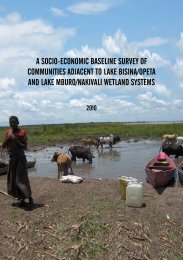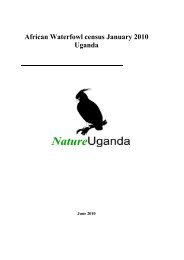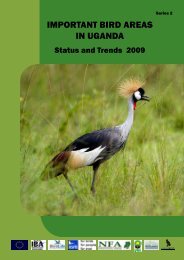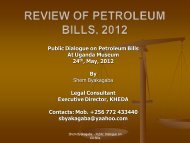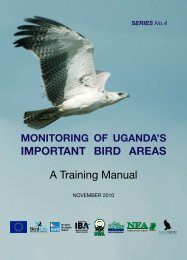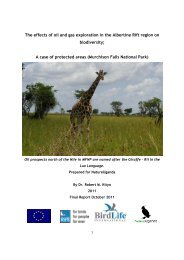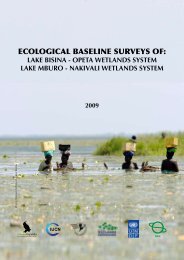the economic valuation of the proposed ... - Nature Uganda
the economic valuation of the proposed ... - Nature Uganda
the economic valuation of the proposed ... - Nature Uganda
You also want an ePaper? Increase the reach of your titles
YUMPU automatically turns print PDFs into web optimized ePapers that Google loves.
ased on household livelihoods.<br />
Bush et al. (2004) estimated <strong>the</strong> total livelihood value<br />
<strong>of</strong> timber (largely poles and firewood) and non-timber<br />
products from a typical protected tropical high forest<br />
in <strong>Uganda</strong> at UShs 18,074 per ha per year, <strong>of</strong> which 47<br />
percent was timber and 53 percent non-timber forest<br />
products. Hence <strong>the</strong> combined annual stream <strong>of</strong> poles<br />
and firewood values was estimated at UShs 8,495/ha.<br />
Since <strong>the</strong> impact area in Mabira CFR is estimated at<br />
7186ha, this gives a benefit stream <strong>of</strong> UShs 61,045,070/<br />
year. Capitalising this annual benefit stream by 12<br />
percent gives a net present value for poles and firewood<br />
<strong>of</strong> UShs 508,708,917. Bush et al (2004) cautioned as<br />
follows.<br />
40<br />
“It is important to note at this point that<br />
<strong>the</strong> values calculated do not imply that<br />
<strong>the</strong> level <strong>of</strong> <strong>economic</strong> value derived is<br />
sustainable. (They estimated <strong>economic</strong><br />
value based on <strong>the</strong> current levels <strong>of</strong> use).<br />
However, it is reasonable to assume that<br />
protected THF [Tropical High Forest]<br />
values are closer to sustainable harvest<br />
rates considering <strong>the</strong> management<br />
efforts <strong>of</strong> <strong>the</strong> NFA”.<br />
In summary, <strong>the</strong> values <strong>of</strong> poles and firewood were<br />
arrived at as follows.<br />
Poles + Firewood livelihood value<br />
UShs 8,495/ha/year<br />
Size <strong>of</strong> Impact Area<br />
7186 ha<br />
Total annual benefit stream<br />
UShs 61,045,070/year<br />
Present Value <strong>of</strong> Poles + Firewood benefits<br />
UShs 508,708,917 (or (US$ 299,241)<br />
B. NON-TIMBER FOREST PRODUCTS<br />
Prescription 32 <strong>of</strong> <strong>the</strong> Mabira Forest Management Plan<br />
1997-2007 had this to say about handicrafts materials.<br />
“Demand for handicraft products,<br />
including easy chairs, stools, mats<br />
and baskets is rising. Although limited<br />
quantities, for domestic use, are permitted<br />
free <strong>of</strong> charge under <strong>the</strong> Forests Act, a<br />
system shall be devised to monitor, record<br />
and control harvesting. Any collection/<br />
harvesting for commercial purposes shall<br />
be fully charged at appropriate rates <strong>of</strong><br />
such forest product”. Karani et al (1997).<br />
For o<strong>the</strong>r non-timber forest products, Prescription 33 <strong>of</strong><br />
<strong>the</strong> Mabira Forest Management Plan 1997-2007 stated<br />
as follows:<br />
“Domestic collection <strong>of</strong> medicinal herbs,<br />
edible plants and o<strong>the</strong>r food materials<br />
does not pose any immediate danger<br />
to <strong>the</strong> resource or <strong>the</strong> standing forest<br />
crop. Such collection may promote<br />
protection and conservation <strong>of</strong> <strong>the</strong><br />
respective forest resource in <strong>the</strong> MPA by<br />
neighbouring communities. However,<br />
levels <strong>of</strong> harvesting shall be controlled<br />
and in case <strong>of</strong> commercial interests,<br />
corresponding fees shall be charged. In<br />
case <strong>of</strong> any destruction to standing forest<br />
crop, e.g. debarking and uprooting, <strong>the</strong><br />
FD (now NFA) <strong>of</strong>ficers shall take steps to<br />
immediately stop such actions” Karani et<br />
al. (1997).<br />
To estimate <strong>the</strong> benefits stream from non-timber forest<br />
products, <strong>the</strong> Bush et al. (2004) study was used. The<br />
results <strong>of</strong> <strong>the</strong> research showed that typical tropical<br />
high forest protected areas (PAs) on average generate<br />
UShs 9,579/ha/year, an amount much lower than<br />
Afromontane forest PAs, private THFs and savanna<br />
woodland/bushland. None<strong>the</strong>less, <strong>the</strong> value for tropical<br />
high forest PA is thought to be <strong>the</strong> closest to <strong>the</strong> Mabira<br />
situation. Using <strong>the</strong> approach similar to <strong>the</strong> one for poles<br />
and firewood, <strong>the</strong> present value <strong>of</strong> <strong>the</strong> benefits stream<br />
The Economic Valuation <strong>of</strong> <strong>the</strong> Proposed Degazettement <strong>of</strong> Mabira CFR | 2011



